He hired Banksy for £50 and then painted over his graffiti

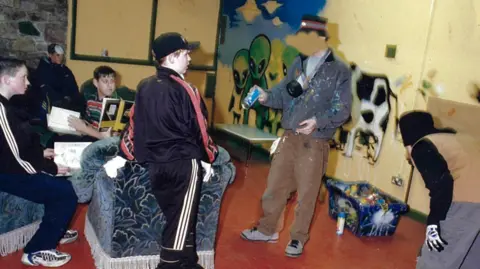 peter de boer
peter de boerFor years people have tried – and failed – to uncover details about Bristol’s most famous, yet anonymous, graffiti artist Banksy.
His photographs and the stories of the people who met him are incredibly rare. But now a man who hired the mystery artist to work with children at a youth club in the late 1990s has given the BBC an exclusive insight into the man behind the graffiti, just as he became famous. Was going to happen.
Banksy is one of the most famous graffiti artists in the world. His work sold for millions of pounds and his exhibitions were visited by millions of people.
But behind the layers of paint lost to time at a Bristol Youth Club is a Banksy few know about.
At the pinnacle of international fame, the artist was making his mark – not only on the streets of his own city, but also on Lawrence Weston’s youth.
Here, Banksy helped groups of teenagers in art classes, just as he was about to paint his famous Mild, Mild West mural.
“If you look at the pictures, you can see how he was working with young people,” said Peter de Boer, the man responsible for bringing Banksy into the building.
“They were engaging, having fun and sharing ideas. It was a true collaboration.”
Now all that remains of these unique murals are photographs, which capture the colourful, abstract and vibrant pieces spread across the walls of the youth club. The BBC has been granted permission to use these photographs on the condition that Banksy remains anonymous.
The artist returned to the club several times to create new worlds in which excited 11 to 16 year olds would hang out – unaware of who the artist would eventually become.
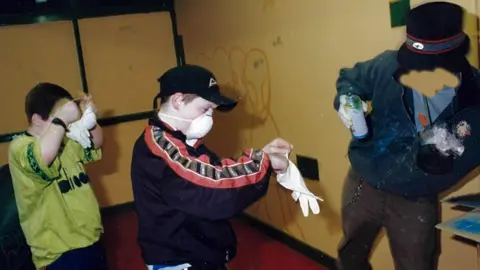 peter de boer
peter de boerIt was the late 1990s when Peter, a senior youth worker in the area, was looking for local artists to inspire a generation of children in this part of west Bristol.
His friend had a suggestion – someone who had been out ‘tagging’ the city with his brother and was starting to make a name for himself. That guy was Banksy.
Peter said, “I’d got his phone number, so I called him and asked if he’d come over and do some art projects. He was really keen.”
This was the same year that Banksy created his first large stencil mural in Stokes Croft – Mild Mild West – which depicted a teddy bear throwing a Molotov cocktail at three riot police.
Whenever Banksy arrived at the youth club, he was greeted by dozens of curious children.
The purpose-built youth center of the 1970s had become a de facto community hub.
“Literally hundreds of young people come here a week,” said Peter, who is passionate about the need for youth clubs in the society.
“It was always very lively.”
Peter recalled the publicity about Banksy’s work in Bristol, but when he was running sessions at Lawrence Weston “nobody thought twice about who he was”.
He was another artist sharing his skills with the community, she said.
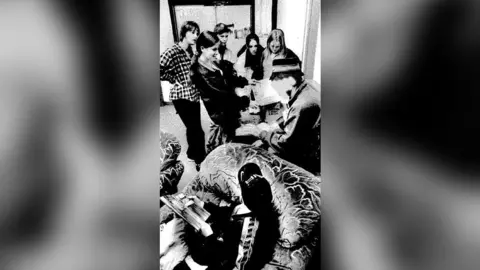 peter de boer
peter de boerHe said, “What struck me then was that he really had no ego. He was doing art with them rather than doing art for them.”
“In the morning, he sat around a table with the children, talking about their ideas.
“Then they will spread all this dirt and spray things that were invented.
“It wasn’t more Banksy than younger people, it was definitely a kind of 50/50 thing.”
And how much did it cost to bring in Banksy?
“For the first (workshop), I think we paid him £50. That probably just covered the cost of the spray paint then,” Peter said.
“I don’t think he ever got into it for the money. It shows what a deep, kind and caring person he is.”
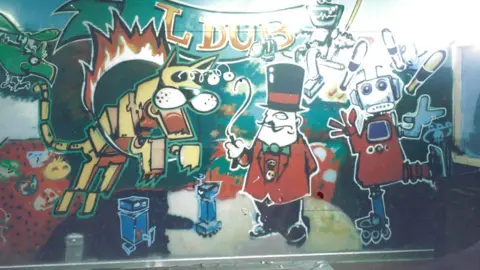 peter de boer
peter de boerThe murals that Banksy created with children were fun and vivid in color – but with meaning.
One of the cows was looking upwards as bombs dropped on them, which Peter believed was a sign of climate concern, while the other was more ambiguous – a circus surrounded by robots.
‘I painted on a Banksy’
But what happened to these graffiti? They were painted. Frequently.
Peter said, “I personally painted a Banksy. I threw away a Banksy stencil when I was cleaning.”
But he is not one to be sentimental about the preservation of street art.
“I don’t regret (hiding them) at all. At that time, it was about working with young people and getting them involved.
“And it was just another art project at the time.”
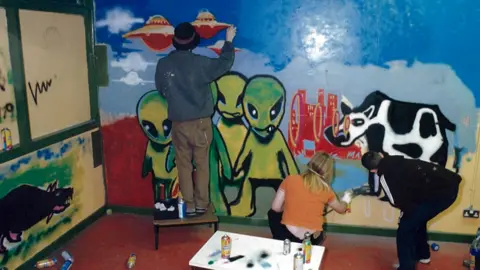 peter de boer
peter de boerFor Peter, the value of Banksy’s time at the club is not monetary, but based on what these murals have done for the community.
He wonders if children remember the creations with the man who is now one of the world’s most famous artists.
“I’m very proud that he came here,” he said.
“There will be young people in the local community (who were) now parents who worked with Banksy, and they might not know it.”






